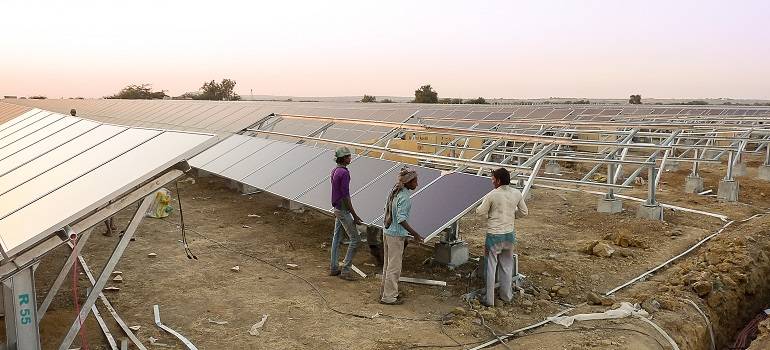
The Uttar Pradesh government will set up around 6,000 solar power plants to meet its clean energy target of 10,700 MW in the next five years, Additional Energy Sources Minister Brijesh Pathak said.
“We have decided to install some 6,000 solar power plants in the state (for this purpose), and also harness solar energy through solar rooftops … I am confident that the intensity of interest evinced by the stakeholders will definitely help the department become the number one department in the entire country,” Pathak told PTI here.
Uttar Pradesh has a solar energy potential of 22,300MW, which the state intends to harness to meet the solar power generation target of 10,700MW fixed by Union Ministry of New and Renewable Energy (MNRE), he said in an interview.
“Ever since the formation of the department of new and renewable energy (Vaikalpik Urja Vibhaag) in 1985, no attention was paid to it. The department was always considered as a vaikalpik (optional) one.
“But, now after the formation of the Yogi Adityanath government in Uttar Pradesh, the department has started getting its due importance, and we have already announced our new policy,” Pathak said.
“The new policy of the department (Uttar Pradesh Solar Power Policy 2017) is available on the internet and anyone can go through it. The policy was made after serious deliberations with all stakeholders and incorporating their suggestions to the maximum possible extent,” he said.
In a major relief to solar energy consumers, the minister said, “if anyone installs solar rooftop panels to produce electricity, then he has been exempted from taking a no- objection certificate. The earlier practice was that officials of power safety directorate would inspect and then give the NOC. We have ended the inspector raj.”
The minister claimed that solar panels have been designed to provide uninterrupted power for 25 years and appealed to people to purchase such panels for enjoying uninterrupted power supply.
“We are not considering solar energy as an optional source of energy, but rather as one of the mainstream sources of energy,” he said. Another thing which has been done by this government is that the authorities will provide transmission lines up to 15 kilometres from solar energy plants of 50-150MW capacity, considering the fact that transmission is a costly affair for common people to bear, he said.
The Uttar Pradesh Solar Power Policy 2017 targets implementation of 10,700 MW of grid-connected solar power projects by the end of 2022.
Of the total capacity, 4,300 MW is targeted to be achieved through deployment of grid connected rooftop projects, and 6,400 MW through ground mounted utility scale power projects.
Encouraged by the successful implementation of solar projects in states like Karnataka and Gujarat, the Uttar Pradesh government led by chief minister Yogi Adityanath invited bids for 100 MW of solar power projects by March. The bids are for projects on open access basis to be set up in the Bundelkhand region.
Top Indian energy companies, including Adani Power, Essel Infraprojects Limited, and Azure Power are bullish about the Uttar Pradesh solar power sector and have shown interest in setting up projects, ministry offiials said.
The three companies have proposed investment to the tune of over Rs 50 billion (Rs 5,000 crore) in this space. Under the new UP solar energy policy 2017, the Yogi Adityanath government is eyeing private investment of Rs 50 billion and attaining solar energy capacity of 10,700 megawatt (MW) over the next 4-5 years.
Other companies in this league include Sukhbir Agro Energy Limited, Amplus Energy Solutions and CleanMax Solar.
According to sources, the memorandum of understanding (MoU) for the proposed investment could be signed during the forthcoming mega “UP Investors Summit” on February 21-22.
UP principal secretary energy and additional energy resources Alok Kumar said of the targetted 10,700 MW of solar energy capacity by 2022, about 6,400 MW would comprise setting up of utility-scale grid solar power projects, which feed directly to the grid under power purchase agreement (PPA).
Meanwhile, more than 40 companies, including all the marquee names, have participated in the tariff-based e-bidding for the procurement of 1,000 MW of solar energy, thus giving a major boost to the UP energy department.
Earlier, UP New and Renewable Energy Development Agency (UPNEDA), the nodal state agency for solar power, had on January 8 invited e-bids for the procurement of 1,000 MW of solar energy.
Under the new policy, the Adityanath government would also prepare an action plan to develop a green energy corridor in the arid Bundelkhand region at an investment of about Rs 40 billion, which would be partly funded by the Centre.
Bundelkhand is ideal for solar energy since it is abundant in the barren land to set up new plants. The setting up of solar energy units would not only give a major economic fillip in the region but also create employment opportunities to stop the migration of youth, Pathak said.
The new industries being set up in Bundelkhand would also get comparatively cheaper power from the solar energy plants to boost industrialisation.
As an added incentive, the new policy allows investors the facility of open access to sell power to individual or institutional consumers within or outside the state. This was restricted in the previous policy framework and they were supposed to feed the entire energy generated by UP Power Corporation Limited (UPPCL) grid.
Also Read:
Seraphim Supplies Eclipse for China’s First 5MW PV Power Plant with Shingled-cell Modules
Budget 2018: Solar industry seeks clarity, relief in safeguard duty

